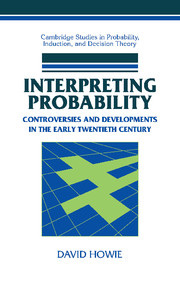Book contents
- Frontmatter
- Contents
- Acknowledgments
- 1 Introduction
- 2 Probability up to the Twentieth Century
- 3 R.A. Fisher and Statistical Probability
- 4 Harold Jeffreys and Inverse Probability
- 5 The Fisher–Jeffreys Exchange, 1932–1934
- 6 Probability During the 1930s
- 7 Epilogue and Conclusions
- Appendix 1 Sources for Chapter 2
- Appendix 2 Bayesian Conditioning as a Model of Scientific Inference
- Appendix 3 Abbreviations Used in the Footnotes
- Bibliography
- Index
3 - R.A. Fisher and Statistical Probability
Published online by Cambridge University Press: 07 July 2009
- Frontmatter
- Contents
- Acknowledgments
- 1 Introduction
- 2 Probability up to the Twentieth Century
- 3 R.A. Fisher and Statistical Probability
- 4 Harold Jeffreys and Inverse Probability
- 5 The Fisher–Jeffreys Exchange, 1932–1934
- 6 Probability During the 1930s
- 7 Epilogue and Conclusions
- Appendix 1 Sources for Chapter 2
- Appendix 2 Bayesian Conditioning as a Model of Scientific Inference
- Appendix 3 Abbreviations Used in the Footnotes
- Bibliography
- Index
Summary
R.A. FISHER'S EARLY YEARS
Ronald Aylmer Fisher was born in 1890 in East Finchley, London. An academic prodigy at Harrow, his interests ranged from mathematics and astronomy to biology and evolution. His mother died while he was still at school, and shortly afterwards his father, an auctioneer of fine art, bankrupted himself through a series of disastrous business deals. The once-prosperous family fell on hard times. In 1908, however, Fisher won a scholarship to Cambridge. Though the rote nature of the degree course in biology led him to plump for mathematics instead, the young Fisher continued to read widely, and finishing the three years of mathematics, returned to Cambridge in 1912 on a one-year physics scholarship.
In this final year, Fisher attended lectures by James Jeans on the quantum theory, and by his college tutor, the astronomer F.J.M. Stratton, on the theory of errors. But by this stage he had discovered a perfect combination of his mathematical and biological interests in Karl Pearson's “mathematical contributions to the theory of evolution.” Fisher was especially attracted to Pearson's focus on human hereditary, and took to eugenics with idealistic zeal. With a group of like-minded friends, he was instrumental in establishing a Cambridge University Eugenics Society – John Maynard Keynes was another founding member – and led discussions of Pearson's ideas and their implications for society. Fisher acted as a steward at the First International Eugenics Conference in 1912, and addressed the larger London Society in October of the following year.
- Type
- Chapter
- Information
- Interpreting ProbabilityControversies and Developments in the Early Twentieth Century, pp. 52 - 80Publisher: Cambridge University PressPrint publication year: 2002

